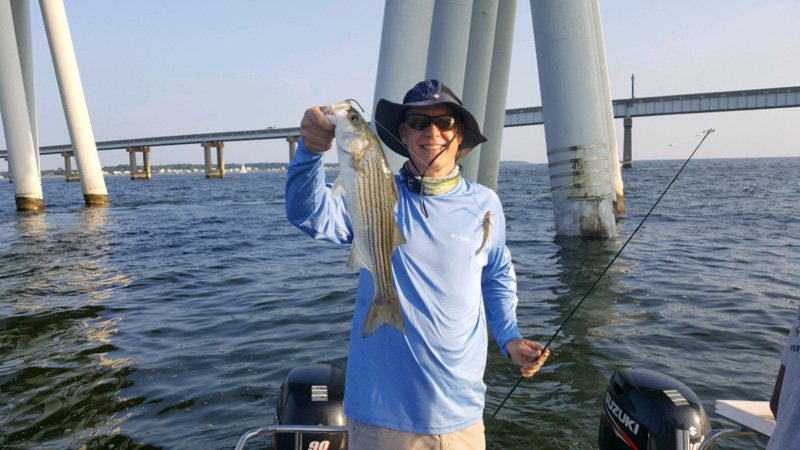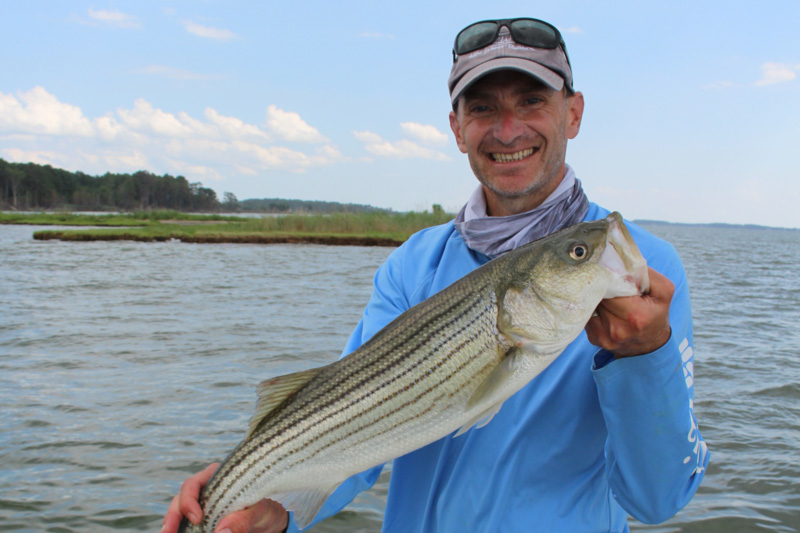If you enjoy Chesapeake Bay fishing during the summer months, chances are you’ve had days where you caught dozens and dozens of undersized rockfish in the quest to find a keeper or two. It’s great to see all those tiny stripers, but sometimes it’s tough to get past all the minnows to catch a keeper. And when dozens of these little fish are caught in the search for one over 20 inches, some are sure to be injured or even die. Is the true mortality number nine percent, as MRIP says? We certainly don’t accept that figure, but the fact remains that some number of fish won’t survive their encounter with you. Fishing with single-hook lures and non-offset circle hooks, and being extremely careful with each and every fish you handle, surely helps keep this number minimized. But no matter how hard you try, when large numbers of fish are caught and released some percentage is bound to be fatally injured.

We all want to catch larger fish in the first place, but you can’t stop those little guys from biting… or, can you?
The Great Rockfish Bait Debate
When fishing with bait, the first and most obvious thing you can do to keep undersized fish from biting as much is to increase the size of your bait. When you’re catching spot for live-lining, toss the four- and five-inchers back and only use six-inch spot for bait. They may look too big, but they aren’t. In fact, it’s utterly amazing how small a striper will eat a spot and any experienced live-liner has pulled up plenty of undersized fish only to exclaim “how the heck did that little rockfish eat this thing?!”
If you’re chumming, instead of the usual domino-sized piece use a fist-sized chunk or a whole bunker head. Small stripers rarely pay any attention to a head, but larger fish swallow them up. While this may sound a little unorthodox, note that in northern coastal waters like New Jersey or New York where school-sized fish are too small to keep, many anglers commonly bait up with whole heads.
Soft or peeler crab and razor clams are baits you’ll want to shy away from entirely when there are zillions of tiny fish around, since fish of any size will recognize them as meals they can handle. Even large baits can be ripped up into small pieces, and unless you get extremely lucky small fish will shred it before the keepers find it.
Using Lures for Lunkers
Up-sizing trolling and jigging lures so they’re large enough to eliminate the vast majority of throwbacks can also eliminate hits from keeper fish, which may be honed in on a particular sized offering similar to the natural baits they’re feeding on. So upsize your offerings a bit, but if you’re not getting bites, reconsider whether or not you’ve gone too far.
There are a few other things you can do to minimize your impact when fishing with artificials. Most importantly, if a lure has treble hooks swap them out for singles. They do less damage to the fish, and since they are easier to unhook, also save you a lot of fishing time normally lost as you try to gently wiggle free a treble without harming the fish.
Another tactic that will help comes into play when you’re casting to breaking fish. Choose fast-sinking lures, let them drop below the main school before retrieving them, and fish them well below the surface. The largest fish in a school will usually hang below the fray on the surface, lazily slurping up injured or killed baitfish that sink below the school of smaller fish.
When you see a surface melee, remember that you can judge the chances of finding keeper fish versus smalls by checking out the type of baitfish being eaten. If there are menhaden there’s a good chance some decent fish will be around. Most of the menhaden don’t leave the rivers and gather in the open Bay until they are at least four or five inches long, and by then the tiny stripers can’t swallow them. The largest of the glass minnow or bay anchovies, however, will be attacked by stripers that can fit in the palm of your hand.
Finding Big Fish
You can also help avoid throwbacks and find larger fish by choosing your location wisely. If you see fish breaking in less than 10 feet of water during the summer months ignore them completely — 99 times out of 100 they’ll be tiny. And when the usual live-line/chumming haunts become inundated with micro-fish, bypass them. Instead, look for smaller humps and bumps that are adjacent to deep water or channels. Spots that come up to 20 or 25 feet on the top and fall into 30, 40, or more feet of water are ideal, as they have the potential to draw a few larger fish instead of the masses of tiny ones.

Light tackle enthusiasts can often find the keepers by concentrating on skinny water structure. Small fish are inclined to school in open water, and if you cast lures to rip-rap, rocks, points, rips, and docks in the shallows, you’re likely to more loaner fish of all different sizes.
Most importantly, when you run into masses of undersized fish, stop catching one after the next and simply go elsewhere. You’re not likely to find keepers mixed in with the little fish, and the more you catch, the more you’re likely to injure one.
Using these techniques, will you probably catch fewer fish overall? Maybe so. I’ll be the first to admit that there are days when I go home with an empty cooler, and it’s not by choice. But it’s well worth the risk, because we want to leave those micro-rock alone as much as possible. Sure, it’s fun reeling them in. But fighting a keeper-sized fish is even more fun. And if we want to keep doing that for years to come, not catching the little guys in the first place is a good place to start.
Responsible Rockfish Catch and Release
When you do pull up a throw-back, remember these safe release tips:
- Wet your hands before handling a fish, or you will remove the fish’s protective coat of slime. For the same reason, NEVER hold a fish with a dry towel — always soak it down first.
- When netting fish, always use a release net which is rubber-coated. Knotted nylon nets (the cheaper ones you see most commonly) can scrape off the fish’s slime and get caught in their jaws and gill plates.
- Grip small stripers by the lower jaw, and never squeeze the fish around the middle. Larger fish that are lipped should be supported with a second hand aft of the belly, so as to not stress the jaw hinge.
- Whenever possible, use a de-hooker or grab the hook or jig head, rotate it upside-down, and gently shake the fish free without touching it at all.
- Whenever possible remove the hook while the fish is still in the water. When air temps are over 90 degrees this is particularly important, as mortality rates skyrocket when fish are exposed to the air in these conditions.
-By Lenny Rudow